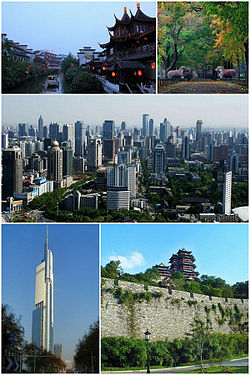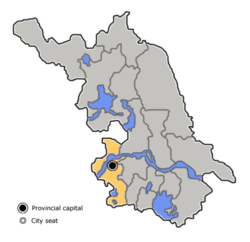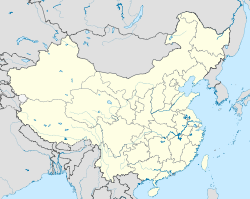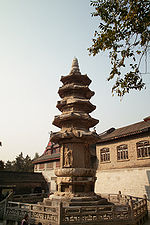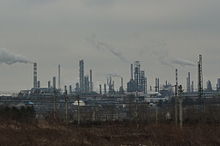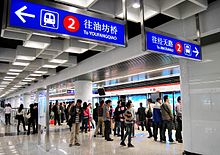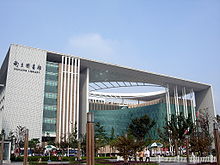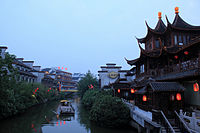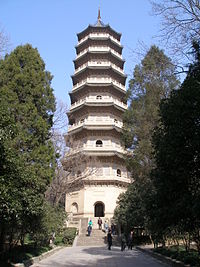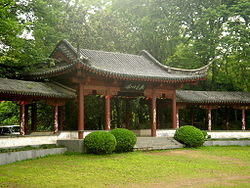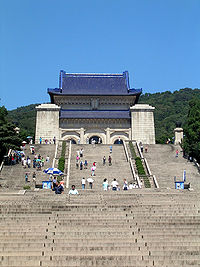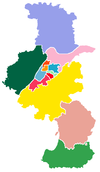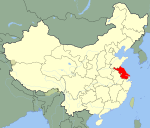- Nanjing
-
Nanjing
南京— Sub-provincial city — 南京市 Clockwise from top: Qinhuai River, Ming Xiaoling Mausoleum, Nanjing Downtown, City Wall of Nanjing, Zifeng Tower Location of Nanjing City (yellow) in Jiangsu Location in China Coordinates: 32°03′N 118°46′E / 32.05°N 118.767°ECoordinates: 32°03′N 118°46′E / 32.05°N 118.767°E Country People's Republic of China Province Jiangsu County-level 13 Township-level 129 Settled 495 BC Government – Type Sub-provincial city – CPC Ctte Secretary Yang Weize – Mayor Ji Jianye Area – Total 6,598 km2 (2,548 sq mi) Elevation 15 m (50 ft) Population (2010) – Total 8,004,680 – Density 1,214/km2 (3,143/sq mi) Demonym Nanjinger Time zone China standard time (UTC+8) Postal code 210000 - 211300 Area code(s) 25 GDP (Nominal) 2010 - Total US$ 77.1 billion - Per capita US$ 9,929 GDP (PPP) 2010 - Total US$ 135.3 billion - Per capita US$ 17,429 Licence plate prefixes 苏A Website City of Nanjing City trees
Deodar Cedar (Cedrus deodara)City flowers
Méi (Prunus mume)Nanjing Chinese 南京 Hanyu Pinyin Nánjīng Literal meaning southern capital Transcriptions Mandarin - Hanyu Pinyin Nánjīng - Wade–Giles Nan-ching - Postal Map Nanking Min - Hokkien POJ Lâm-kiaⁿ Wu - Romanization noe平cin平 Cantonese (Yue) - Jyutping naam4ging1  Nanjing (Chinese: 南京, pinyin: Nánjīng, Wade-Giles: Nan-ching) is the capital of Jiangsu province in China and has a prominent place in Chinese history and culture, having been the capital of China on several occasions. Its present name means "Southern Capital" and was widely romanized as Nankin and Nanking until the Pinyin language reform, after which Nanjing was gradually adopted as the standard spelling of the city's name in most languages that use the Roman alphabet.
Nanjing (Chinese: 南京, pinyin: Nánjīng, Wade-Giles: Nan-ching) is the capital of Jiangsu province in China and has a prominent place in Chinese history and culture, having been the capital of China on several occasions. Its present name means "Southern Capital" and was widely romanized as Nankin and Nanking until the Pinyin language reform, after which Nanjing was gradually adopted as the standard spelling of the city's name in most languages that use the Roman alphabet.Located in the lower Yangtze River drainage basin and Yangtze River Delta economic zone, Nanjing has long been one of China's most important cities. It is recognized as one of the Four Great Ancient Capitals of China. It was the capital of Sun Quan's Wu during the Three Kingdoms Period and the capital of the Republic of China prior to its flight to Taiwan during the Chinese Civil War. Nanjing is also one of the fifteen sub-provincial cities in the People's Republic of China's administrative structure, enjoying jurisdictional and economic autonomy only slightly less than that of a province. Nanjing has long been a national center of education, research, transport networks, and tourism. The city will host the 2014 Summer Youth Olympics.
With an urban population of over five million (2006), Nanjing is the second-largest commercial center in the East China region after Shanghai. It has been ranked seventh in the evaluation of "Cities with Strongest Comprehensive Strength" issued by the National Statistics Bureau, and second in the evaluation of cities with most sustainable development potential in the Yangtze River Delta. It has also been awarded the title of 2008 Habitat Scroll of Honor of China, Special Award of UN Habitat Scroll of Honor and National Civilized City.[1]
Contents
History
Early history
Nanjing was one of the earliest established cities in what is now China. According to legend,[which?] Fu Chai, Lord of the State of Wu, founded a fort named Yecheng (冶城) in today's Nanjing area in 495 BCE. Later in 473 BCE, the State of Yue conquered Wu and constructed the fort of Yuecheng (越城) on the outskirts of the present-day Zhonghua Gate. In 333 BCE, after eliminating the State of Yue, the State of Chu built Jinling Yi (金陵邑) in the western part of present-day Nanjing. Under the Qin and Han dynasties, it was called Moling (秣陵). Since then, the city has experienced destruction and renewal many times.,[citation needed]
Capital of the Six Dynasties
Nanjing first became a capital in 229 CE, where Sun Quan of the Wu Kingdom during the Three Kingdoms Period relocated its capital to Jianye (建業), a city he extended on the basis of Jinling Yi in 211 CE. Although conquered by the West Jin Dynasty in 280, Nanjing and its neighboring areas had been well cultivated and developed into one of the commercial, cultural, and political centers of China during the rule of East Wu. This city would soon play a vital role in the following centuries.
Shortly after the unification of the region, the West Jin state collapsed in wars. It was at first rebels of eight Jin princes for the throne and later rebels and invasion from Xiongnu and other nomadic peoples that destroyed the rule of Jin in the north. In 317, remnants of the Jin court, as well as nobles and wealthy families, fled from the north to the south and reestablished the Jin court in Nanjing, which was then called Jiankang (建康).
During the period of the North-South Division, Nanjing remained the capital of the Southern Dynasties for more than two and a half centuries. During this time, Nanjing was the international hub of the East Asia and one of the largest city in the world. Based on historical documents, the city had 280,000 registered households.[2] Assuming an average Nanjing household had about 5.1 people at that time, the city had more than 1.4 million residents.[citation needed]
A number of sculptural ensembles of that era, erected at the tombs of royals and other dignitaries, have survived (in various degrees of preservation) in Nanjing's northeastern and eastern suburbs, primarily in Qixia and Jiangning District.[3] Possibly the best preserved of them is the ensemble of the Tomb of Xiao Xiu (475–518), a brother of Emperor Wu of Liang.[4][5] The period of division ended when the Sui Dynasty reunified China and destroyed almost the entire city, turning it into a small town.
Medieval period
The city of Nanjing was razed after Sui took it. It was reconstructed during late Tang Dynasty. It was again chosen as the capital as Jinling (金陵) during the short-lived Southern Tang (937–975), who succeeded the Wu.[6] Jiankang's textile industry burgeoned and thrived during Song Dynasty despite the constant threat from the northern foreign invasions. The Mongolians, the occupiers of China, further consolidated the city's status as a hub of the textile industry under the Yuan Dynasty.
Capital of the Ming
Zhonghua Gate is the south gate of the walled city of Nanjing. The city wall was built in the 14th century and is the longest in the world.
The first emperor of the Ming Dynasty Zhu Yuanzhang (the Hongwu Emperor) who overthrew the Yuan Dynasty rebuilt this city and made it the dynastic capital in 1368. He constructed what was the longest city wall in the world at that time. It took 200,000 laborers 21 years to finish the project. The present-day city wall of Nanjing was mainly built during that time,[dubious ] and it is the longest surviving city wall in the world.
Nanjing remained the capital of the Ming Empire until 1421, when the third emperor of the dynasty, Zhu Di (the Yongle Emperor), relocated the capital to Beijing. It is believed that Nanjing was the largest city in the world from 1358 to 1425 with a population of 487,000 in 1400.[7]
Besides the city wall, other famous Ming-era structures in the city included the famous Ming Xiaoling Mausoleum and Porcelain Tower, although the latter was destroyed by the Taipings in the 19th century.
A monument to the huge human cost of some of the gigantic construction projects of the early Ming is the Yangshan Quarry (located some 10 km (6 mi) east of the walled city an Ming Xiaoling), where a gigantic stele, cut on the orders of the Yongle Emperor, lies abandoned, just as it was left 600 years ago when it was understood that it is impossible to move or erect it.[8]
As the center of the empire, early-Ming Nanjing had worldwide connections: it was home of the eunuch admiral Zheng He, who went to sail the Pacific and Indian Oceans, and it was visited by foreign dignitaries, such as the sultan of Brunei Abdul Majid Hassan, who died during his visit to China in 1408. The sultan's grave, with a suitably royal spirit way and a tortoise stele, was discovered in Yuhuatai District (south of the walled city) in 1958, and has been restored.[9]
Qing period
Over two centuries after the removal of the capital to Beijing, Nanjing was destined to become the capital of a Ming emperor one more time. After the fall of Beijing to the Li Zicheng's rebels and then to Manchu Qing invaders, and the suicide of the last "real" Ming emperor Zhu Youjian (the Chongzhen Emperor) in the spring 1644, the Ming prince Zhu Yousong was enthroned in Nanjing in June 1644 as the Hongguang Emperor. His short reign was described by later historians as the first reign of the so-called Southern Ming Dynasty.
Zhu Yousong, however, fared a lot worse than his ancestor Zhu Yuanzhang three centuries earlier. Beset by factional conflicts, his regime could not offer effective resistance to Manchu troops, when the Manchu army, led by Prince Dodo approached Jiangnan the next spring.[10] Days after Yangzhou fell to the Manchus in late May 1645, the Hongguang Emperor fled Nanjing, and the imperial palace was looted by local residents.[11] On June 6, Dodo's troops approached Nanjing, and the commander of the city's garrison, Zhao the Earl of Xincheng, promptly surrendered the city to them.[12] The Manchus soon ordered all male residents of the city to shave their heads in the Manchu way, requisitioned a large section of the city for the bannermen's cantonment, and destroyed the former imperial palace, but otherwise the city was spared the mass murders and destruction that befell Yangzhou.[13]
Under the Qing Dynasty (1644–1911), the Nanjing area was known as Jiangning (江寧) and served as the seat of government for the Liangjiang Viceroy. It had been visited by the Kangxi and Qianlong Emperors a number of times on their tours of the southern provinces.
Nanjing was invaded by British troops during the close of the First Opium War, which was ended by the Treaty of Nanking in 1842.
As the capital of the brief-lived Taiping Kingdom[14] in the mid-19th century, Nanjing was known as Tianjing (天京, "Heavenly Capital" or "Capital of Heaven") Both the Qing Viceroy and the Taiping king resided in buildings that would later be known as the Presidential Palace. When the Qing under Zeng Guofan retook the city in 1864, a massive slaughter occurred in the city with over 100,000 estimated to have committed suicide or fought to the death.[citation needed]
Capital of the Republic
The Xinhai Revolution led to the founding of the Republic of China in January 1912 with Dr. Sun Yat-sen as the first provisional president and Nanjing was selected as its new capital. However, the Qing Dynasty still controlled the northern provinces, so revolutionaries asked Yuan Shikai to replace Sun as president in exchange for the emperor's abdication. Yuan demanded the capital be at Beijing (closer to his power base).
In 1927, the Kuomintang (KMT) under Generalissimo Chiang Kai-shek again established Nanjing as the capital of the Republic of China, and this became internationally recognized once KMT forces took Beijing in 1928. The following decade is known as the Nanjing decade.
In 1937, Japan again invaded China, beginning the Second Sino-Japanese War (often considered a theater of World War II). Their troops occupied Nanjing in December and carried out the systematic and brutal Nanking massacre (the "Rape of Nanking"). The total death toll, including those made by the International Military Tribunal for the Far East and the Nanjing War Crimes Tribunal, put the number of dead between 300,000 and 350,000.[15] The Nanjing Massacre Memorial Hall was built in 1985 to commemorate this event.
A few days before the fall of the city, the National Government of China was relocated to the southwestern city Chungking (now Chongqing) and resumed Chinese resistance. In 1940,a Japanese-collaborationist government known as the "Nanjing Regime" or "Nanjing Nationalist Government" led by Wang Jingwei was established in Nanjing as a rival to Chiang Kai-Shek's government in Chongqing. In 1946, after the Surrender of Japan, the KMT relocated its central government back to Nanjing.
People's Republic of China
On April 23, 1949, the People's Liberation Army conquered Nanjing. After the establishment of the People's Republic of China in October, Nanjing was initially a province-level municipality, but very soon became and today remains the provincial capital of Jiangsu.
Geography and climate
Nanjing Climate chart (explanation) J F M A M J J A S O N D 377−147918213573201110226161932921186322512932247227196522135116624100Average max. and min. temperatures in °C Precipitation totals in mm Source: CMA[16] Imperial conversion J F M A M J J A S O N D 1.545301.948333.256412.96951478617.684697.389765.189762.881672.67255261430.95033Average max. and min. temperatures in °F Precipitation totals in inches Nanjing, with a total land area of 6,598 square kilometres (2,548 sq mi), is situated in one of the largest economic zones of China, the Yangtze River Delta, which is part of the downstream Yangtze River drainage basin. The Yangtze River flows past the west side of Nanjing City, while the Ningzheng Ridge surrounds the north, east and south side of the city. The city is 300 kilometres (190 mi) west-northwest of Shanghai, 1,200 kilometres (750 mi) south-southeast of Beijing, and 1,400 kilometres (870 mi) east-northeast of Chongqing.
Nanjing borders Yangzhou to the northeast, one town downstream when following the north bank of the Yangtze, Zhenjiang to the east, one town downstream when following the south bank of the Yangtze, and Changzhou to the southeast. On its western boundary is Anhui Province, where Nanjing borders 5 prefecture-level cities.
Nanjing has a humid subtropical climate (Köppen Cfa) and is under the influence of the East Asia Monsoon. The four seasons are distinct here, with damp conditions seen throughout the year, very hot and muggy summers, cold, damp winters, and in between, spring and autumn are of reasonable length. Along with Wuhan and Chongqing, Nanjing is traditionally referred to as one of the "Three Furnacelike Cities" along the Yangtze River (长江流域三大火炉) for the perennially high temperatures in the summertime.[17] However, the time from mid-June to the end of July is the plum blossom blooming season in which the meiyu (rainy season of East Asia; literally "plum rain") occurs, during which the city experiences a period of mild rain as well as dampness. Typhoons are uncommon but possible in the late stages of summer and early part of autumn. The annual mean temperature is around 15.5 °C (59.9 °F), with monthly mean values ranging from 2.4 to 27.8 °C (36.3 to 82 °F). The highest recorded temperature is 43.0 °C (109 °F) , and the lowest −16.9 °C (2 °F).[18] On average precipitation falls 115 days out of the year, and the average annual rainfall is 1,062 millimetres (42 in).
Nanjing is endowed with rich natural resources, which include more than 40 kinds of minerals. Among them, iron and sulfur reserves make up 40 percent of those of Jiangsu province. Its reserves of strontium rank first in East Asia and the South East Asia region. Nanjing also possesses abundant water resources, both from the Yangtze River and groundwater. In addition, it has several natural hot springs such as Tangshan Hot Spring in Jiangning and Tangquan Hot Spring in Pukou.
Nanjing is the intersection of Yangtze River – an east-west water transport artery and Nanjing-Beijing railway—a south-north land transport artery, hence the name “door of the east and west, throat of the south and north”. Furthermore, the west part of the Ningzhen range is in Nanjing; the Loong-like Zhong Mountain is curling in the east of the city; the tiger-like Stone Mountain is crouching in the west of the city, hence the name “the Zhong Mountain, a dragon curling, and the Stone Mountain, a tiger crouching”. Mr. Sun Yet-sen spoke highly of Nanjing in the “Constructive Scheme for Our Country”, “The position of Nanjing is wonderful since mountains, lakes and plains all integrated in it. It is hardly [sic] to find another city like this.”
Surrounded by the Yangtze River and mountains, Nanjing also enjoys beautiful natural scenery. Natural lakes such as Xuanwu Lake and Mochou Lake are located in the center of the city and are easily accessible to the public, while hills like Purple Mountain are covered with evergreens and oaks and host various historical and cultural sites. Sun Quan relocated his capital to Nanjing after Liu Bei's suggestion as Liu Bei was impressed by Nanjing's impeccable geographic position when negotiating an alliance with Sun Quan. Sun Quan then renamed the city from Moling (秣陵) to Jianye (建邺) shortly thereafter.[19]
Climate data for Nanjing (1971–2000) Month Jan Feb Mar Apr May Jun Jul Aug Sep Oct Nov Dec Year Average high °C (°F) 7.0
(44.6)8.8
(47.8)13.4
(56.1)20.3
(68.5)25.6
(78.1)28.8
(83.8)31.9
(89.4)31.7
(89.1)27.3
(81.1)22.2
(72.0)15.9
(60.6)10.0
(50.0)20.2 Average low °C (°F) −1.1
(30.0)0.6
(33.1)4.8
(40.6)10.6
(51.1)15.9
(60.6)20.7
(69.3)24.6
(76.3)24.2
(75.6)19.2
(66.6)12.9
(55.2)6.1
(43.0)0.4
(32.7)11.6 Precipitation mm (inches) 37.4
(1.472)47.1
(1.854)81.8
(3.22)73.4
(2.89)102.1
(4.02)193.4
(7.614)185.5
(7.303)129.2
(5.087)72.1
(2.839)65.1
(2.563)50.8
(2)24.4
(0.961)1,062.3
(41.823)% humidity 76 74 74 73 74 78 81 81 79 77 76 74 76.4 Avg. precipitation days (≥ 0.1 mm) 8.1 9.1 12.1 10.4 10.4 11.3 12.4 11.3 8.9 8.2 7.4 5.7 115.3 Sunshine hours 129.1 123.3 136.1 168.1 194.0 171.9 205.6 214.7 167.2 169.1 153.5 150.2 1,982.8 Source: China Meteorological Administration[16] Government
The full name of the government of Nanjing is "People's Government of Nanjing City". The city is under the one-party rule of the CPC, with the CPC Nanjing Committee Secretary as the de facto governor of the city and the mayor as the executive head of the government working under the secretary.
Nanjing currently consists of thirteen county-level divisions, of which eleven are districts, and two are counties. The districts are the urban areas of Nanjing while the counties are the rural areas governed by the city.
Administrative divisions
The sub-provincial city of Nanjing has direct jurisdiction over 11 districts (区 qu) and 2 Counties (县 xian):
Map Subdivision Hanzi 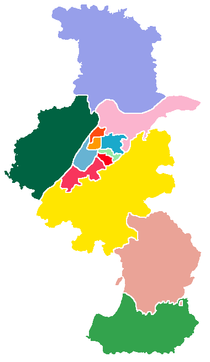
Nanjing City Proper ■ Xuanwu-qu 玄武区 ■ Baixia-qu 白下区 ■ Qinhuai-qu 秦淮区 ■ Jianye-qu 建邺区 ■ Xiaguan-qu 下关区 ■ Gulou-qu 鼓楼区 ■ Yuhuatai-qu 雨花台区 ■ Qixia-qu 栖霞区 Nanjing Suburban and Rural ■ Jiangning-qu 江宁区 ■ Pukou-qu 浦口区 ■ Luhe-qu 六合区 ■ Lishui-xian 溧水县 ■ Gaochun-xian 高淳县 The current partition of districts of Nanjing might change in the future. There was a rumor that Lishui County would be designated as a new urban district in the near future.
Demographics
Population trend Year Residents (in million) natural growth rate (%) 1949 2.5670 13.09 1950 2.5670 15.64 1955 2.8034 19.94 1960 3.2259 0.23 1965 3.4529 25.58 1970 3.6053 20.76 1975 3.9299 9.53 1978 4.1238 8.84 1980 4.3587 8.08 1985 4.6577 4.56 1990 5.0182 9.18 Year Residents (in million) natural growth rate (%) 1995 5.2172 2.62 1996 5.2543 2.63 1997 5.2982 2.16 1998 5.3231 1.00 1999 5.3744 2.01 2000 5.4489 2.48 2001 5.5304 1.60 2002 5.6328 0.70 2003 5.7223 1.50 2006 6.0700 6.11 According to the Sixth China Census, the total population of the City of Nanjing reached 8.005 million in 2010. The statistics in 2008 estimated the total population to be 7.7 million, while the registered population was 6.3 million. The birth rate was 8.86 percent and the death rate was 6.88 percent. The urban area had a population of 5.5 million people.
As in most of eastern China the ethnic makeup of Nanjing is predominantly Han nationality (98.56 percent), with 50 other minority nationalities. In 1999, 77,394 residents belonged to minority nationalities, among which the vast majority (64,832) were Hui nationalities, contributing 83.76 percent to the minority population. The second and third largest minority groups were Manchu (2,311) and Zhuang (533) nationalities. Most of the minority nationalities resided in Jianye District, comprising 9.13 percent of the district's population.
In 2010 the sex ratio of the city population was 107.31 males to 100 females.
Economy
Earlier development
Since the Three Kingdoms period, Nanjing has become an industrial center for textile and mint owing to its strategic geographical location and convenient transportation. During the Ming Dynasty Nanjing's industry was further expanded, and the city became one of the most prosperous cities in China and even the world. It led in textile, mint, printing, shipbuilding and many other industries, and was the busiest business center in the Far East.
Into the first half of the twentieth century, Nanjing gradually shifted from a production hub into a heavy consumption city, mainly because of the rapid expansion of the wealthy population after Nanjing once again regained the political spotlight of China. A number of huge department stores such as Zhongyang Shangchang sprouted up, attracting merchants from all over China to sell their products in Nanjing. In 1933, the revenue generated by the food and entertainment industry in the city exceeded the sum of the output of the manufacturing and agriculture industry. One third of the city population worked in the service industry, while prostitution, drugs and gambling also thrived.
In the 1950s, the CPC invested heavily in Nanjing to build a series of state-owned heavy industries, as part of the national plan of rapid industrialization. Electrical, mechanical, chemical and steel factories were established successively, converting Nanjing into a heavy industry production center of East China. Overenthusiastic in building a “world-class” industrial city, leaders of Nanjing also made many disastrous mistakes during the development, such as spending hundreds of millions of yuan to mine for non-existent coal, resulting in the negative economic growth in the late 1960s.
Today
The current industry of the city basically inherited the characteristics of the 1960s, with electronics, cars, petrochemical, iron and steel, and power as the "Five Pillar Industries". Some representative big state-owned firms are Panda Electronics, Jincheng Motors and Nanjing Steel. The tertiary industry also regained prominence, accounting for 44 percent of the GDP of the city. The city is also vying for foreign investment against neighboring cities in the Yangtze River Delta, and so far a number of famous multinational firms, such as Volkswagen Group, Iveco, A.O. Smith, and Sharp, have established their lines there. Since China's entry into the WTO, Nanjing has received increasing attention from foreign investors, and on average, two new foreign firms establish offices in the city every day.
The city government is further improving the desirability of the city to investors by building large industrial parks, which now total four: Gaoxin, Xingang, Huagong and Jiangning. Despite the effort, Nanjing's Gross Domestic Product is still falling behind that of other neighbouring cities such as Suzhou, Wuxi and Hangzhou, which have an edge in attracting foreign investment and local innovation. In addition, the traditional state-owned enterprises find themselves incapable of competing with efficient multinational firms, and hence are either mired in heavy debt or forced into bankruptcy or privatization. This has resulted in large numbers of layoff workers who are technically not unemployed but effectively jobless.
In recent years, Nanjing has been developing its economy, commerce, industry, as well as city construction. In 2010 the city's GDP was RMB 501 billion (3rd in Jiangsu), and GDP per capita was RMB 65,490, a 13 percent increase from 2009. The average urban resident's disposable income was RMB 28,312, while the average rural resident's net income was RMB 11,050. The registered urban unemployment rate was 3.02 percent, lower than the national average (4.3 percent). Nanjing's Gross Domestic Product ranked 14th in 2010 in China, and its overall competence ranked 5th in mainland and 7th including Taiwan and Hongkong.
Industrial zones
- Nanjing Baixia Hi-Tech Industrial Zone
Nanjing Baixia Hi-Tech Industrial Zone is a national hi-tech industrial zone with 16.5 square kilometers planned area. The zone is only 13.5 km away from Nanjing downtown and 50 km away from Nanjing Lukou Airport. Several expressways pass through here. It is well equipped with comprehensive facilities, and it provides a good investment environment for high-tech industries. Electronic industry, automobile, chemical, machinery, instruments and building materials are the encouraged industries in the zone.[20]
- Nanjing Economic and Technological Development Zone
Established in 1992, Nanjing Economic and Technological Development Zone is a national level zone surrounded by convenient transportation network. Nanjing is the capital of Jiangsu Province. Situated in the downstream of Yangtze River Drainage Basin and Yangtze River Delta economic zone, Nanjing has always been a national center of commerce, education, research, transportation and tourism in the East China region, preceded only by Shanghai. It is only 20 km away from Nanjing Port and 40 km away from Nanjing Lukou Airport. It is well equipped with basic facilities like electricity, water, communication, gas, steam and so on. It has formed four specialized industries, which are electronic information, bio-pharmaceutical, machinery and new materials industry.[21]
- Nanjing Export Processing Zone
On March 10, 2003 the State Council approved the establishment of this Export Processing Zone (EPZ) in Nanjing's Southern District. This EPZ is free from import/export duty area and provides 24-hour customs-bonded conditions. It has a planned area of 3 square km. The Central Government has given the special economic region preferential policies to attract more enterprises engaged in processing trade investment in the region. It is only 20 km from Nanjing Port and several expressways pass through here.[22]
- Nanjing New & High-Tech Industry Development Zone
Nanjing New & High-Tech Industry Development Zone was jointly founded by Jiangsu Provincial People's Government and Nanjing Municipal People's Government, and started to break ground of construction on September 1, 1988. It was established as a national new and high-tech industry development zone by the State Council on March 6, 1991. The zone is next to National Highway 104 and 312. Its pillar industries include electronic information, bio-engineering and pharmaceutical industry.[23]
Cityscape
Day time
Transportation
Nanjing is the transportation hub in eastern China and the downstream Yangtze River area. Different means of transportation constitute a three-dimensional transport system that includes land, water and air. As in most other Chinese cities, public transportation is the dominant mode of travel of the majority of the citizens. The city now has four bridge or tunnel crossings spanning the Yangtze, which are tying districts north of the river with the city center on the south bank. See also Transport in Nanjing.
Rail
Nanjing is an important railway hub in eastern China. It serves as rail junction for the Beijing-Shanghai (Jinghu) (which is itself composed of the old Jinpu and Huning Railways), Nanjing-Wuhu (Ningwu), Nanjing-Qidong (Ningqi), Nanjing-Xian (Ningxi), Hefei-Nanjing (Hening) Railways. Currently, Nanjing has been connected within the high-speed railway network by Beijing–Shanghai High-Speed Railway and Shanghai–Nanjing Intercity High-Speed Railway, and more high-speed rail constructions will be finished in recent years.
Passenger rail service in Nanjing is provided by Nanjing Railway Station and Nanjing South Railway Station, while Nanjing West Railway Station, Zhonghuamen Railway Station and Xianlin Railway Station serve minor roles. Nanjing South Railway Station, which is one of the 5 hub stations on Beijing-Shanghai High-Speed Railway, has officially been claimed as the largest railway station in Asia in terms of GFA (Gross Floor Area).
Road
As an important regional hub in the Yangtze River Delta, Nanjing is well-connected by over 60 state and provincial highways to all parts of China.
Express highways such as Hu-Ning, Ning-He, Ning-Hang enable commuters to travel to Shanghai, Hefei, Hangzhou, and other important cities quickly and conveniently. Inside the city of Nanjing, there are 230 kilometres (140 mi) of highways, with a highway coverage density of 3.38 kilometers per hundred square kilometers (2.10 mi/38.6 sq mi). The total road coverage density of the city is 112.56 kilometers per hundred square kilometers (69.94 mi/38.6 sq mi).
Nanjing Sample Technology Company Limited is a major provider of Intelligent traffic systems.
Expressways:
- G42 Shanghai-Chengdu Expressway
- G40 Shanghai-Xi'an Expressway
- G25 Changchun-Shenzhen Expressway
- G36 Nanjing-Luoyang Expressway
- G4211 Nanjing-Wuhu Expressway
- S55 Nanjing-Gaochun Expressway
- S38 Yanjiang Expressway
- G2501 Nanjing Ring Expressway
- and also several CRH(China railway high-speed)lines(中国高速铁路 or “中国动车组”)
National Highway:
Public Transportation
The city also boasts an efficient network of public transportation, which mainly consists of bus, taxi and metro systems. The bus network, which is currently run by five companies (Nanjing Gongjiao, Zhongbei, Argos, Xincheng and Xinningpu), provides more than 370 routes covering all parts of the city and suburban areas. Nanjing Metro Line 1, started service on May 15, 2005. Line 2 and the extension of Line 1 officially opened to passenger service on May 28, 2010. The city is planning to complete a 655-kilometer (409 mi)-long Metro and light-rail system by 2030.[citation needed] The expansion of the Metro network will greatly facilitate the intracity transportation and reduce the currently heavy traffic congestion.
Air
Nanjing's airport, Lukou International Airport, serves both national and international flights. In 2010, the airport handled 12.5305 million passengers. It was ranked 14th among 126 civil airports in China in terms of yearly passenger transport, and 10th for yearly cargo transport. The airport currently has 85 routes to national and international destinations, which include Japan, Korea, Thailand, Malaysia, Singapore and Germany. The airport is connected by a 29-kilometer (18 mi) highway directly to the city center, and is also linked to various intercity highways, making it accessible to the passengers from the surrounding cities.
Water
Port of Nanjing is the largest inland port in China, yearly throughput reaching 108.59 million tons in 2007. The port area is 98 kilometres (61 mi) in length and has 64 berths including 16 berths for ships with a tonnage of more than 10,000. Nanjing is also the biggest container port along the Yangtze River; in March 2004, the one million container-capacity base, Longtan Containers Port Area opened, further consolidating Nanjing as the leading port in the region. In the 1960s the first Yangtze river bridge was completed, becoming almost the only solid connection between North and South in eastern China at that time. The bridge became a source of pride and an important symbol of modern China, having been built and designed by the Chinese themselves following failed surveys by other nations and the reliance on and then rejection of Soviet expertise. Begun in 1960 and opened to traffic in 1968, the bridge is a two-tiered road and rail design spanning 4,600 metres on the upper deck, with approximately 1,580 metres spanning the river itself.
Culture and art
Being one of the four ancient capitals of China, Nanjing has always been a cultural center attracting intellectuals from all over the country. In the Tang and Song dynasties, Nanjing was a place where poets gathered and composed poems reminiscent of its luxurious past; during the Ming and Qing Dynasties, the city was the official imperial examination center for the Jiangnan region, again acting as a hub where different thoughts and opinions converged and thrived.
Today, with a long cultural tradition and strong support from local educational institutions, Nanjing is commonly viewed as a “city of culture” and one of the more pleasant cities to live in China.
Art
Some of the leading art groups of China are based in Nanjing; they include the Qianxian Dance Company, Nanjing Dance Company, Jiangsu Peking Opera Institute and Nanjing Xiaohonghua Art Company among others.
Jiangsu Province Kun Opera is one of the best theatres for Kunqu, China's oldest stage art. It is considered a conservative and traditional troupe. Nanjing also has professional opera troupes for the Yang, Yue (shaoxing), Xi and Jing (Chinese opera varieties) as well as Suzhou pingtan, spoken theatre, and puppet theatre.
Jiangsu Art Gallery is the largest gallery in Jiangsu Province, presenting some of the best traditional and contemporary art pieces of China; many other smaller-scale galleries, such as Red Chamber Art Garden and Jinling Stone Gallery, also have their own special exhibitions.
Festivals
Main article: List of Festivals and Events of NanjingMany traditional festivals and customs were observed in the old times, which included climbing the City Wall on January 16, bathing in Qing Xi on March 3, hill hiking on September 9 and others (the dates are in Chinese lunar calendar). Almost none of them, however, are still celebrated by modern Nanjingese.
Instead, Nanjing, as a popular tourist destination, hosts a series of government-organised events throughout the year. The annual International Plum Blossom Festival held in Plum Blossom Hill, the largest plum collection in China, attracts thousands of tourists both domestically and internationally. Other events include Nanjing Baima Peach Blossom and Kite Festival, Jiangxin Zhou Fruit Festival and Linggu Temple Sweet Osmanthus Festival.
Libraries
Nanjing Library, founded in 1907, houses more than 7 million volumes of printed materials and is the third largest library in China, after the National Library in Beijing and Shanghai Library. Other libraries, such as city-owned Jinling Library and various district libraries, also provide considerable amount of information to citizens. Nanjing University Library, owned by Nanjing University, with a collection of 4.2 million volumes, is the second largest university libraries in China after Peking University Library. More than 100 multimedia networked-computers are available to readers.
Museums
Nanjing has some of the oldest and finest museums in China. Nanjing Museum, formerly known as National Central Museum under KMT rule, is the first modern museum and remains as one of the leading museums in China. Other museums include the China Modern History Museum in the Presidential Palace, the Nanjing Massacre Memorial Hall, the City Museum of Nanjing, the Taiping Kingdom History Museum, the Nanjing Customs Museum, the Nanjing City Wall Cultural Museum, and a small museum and tomb honoring the 15th century seafaring admiral Zheng He.
Theatre
Most of Nanjing's major theatres are multi-purpose, used as convention halls, cinemas, musical halls and theatres on different occasions. The major theatres include the People's Convention Hall and the Nanjing Arts and Culture Center.
Night life
Traditionally Nanjing's nightlife was mostly centered around Confucius Temple area along the Qinhuai River, where night markets, restaurants and pubs thrived. Boating at night in the river was a main attraction of the city. Thus, one can see the statues of the famous teachers and educators of the past not too far from those of the courtesans who educated the young men in the other arts.
In the past 20 years, several commercial streets have been developed, hence the nightlife has become more diverse: there are shopping malls opening late in the Xinjiekou CBD and Hunan Road. The well-established "Nanjing 1912" district hosts a wide variety of pastime facilities ranging from traditional restaurants and western pubs to dance clubs. There are two major areas where bars are densely located; one is in 1912 block; the other is along Shanghai road and its neighborhood. Both are popular with international residents of the city.
These days, the most comprehensive source of nightlife information (in English) can be found on HelloNanjing.net and NanjingExpat.com.
Local people still very much enjoy street food, such as Kababu. As elsewhere in Asia, Karaoke is popular with both young and old crowd.
Sports and stadiums
As one of the majors cities, Nanjing is the ground of many professional sports teams. Jiangsu Sainty, the football club currently staying in China Super League, is a long-term tenant of Nanjing Olympic Sports Center. Another football club that plays in secondary China professional level, China Jia League is Nanjing Yo Yo who hosts Wutaishan Sports Center as their home stadium. Jiangsu Nangang Basketball Club is a competitive team which has long been one of the major clubs fighting for the title in China top level league, CBA. Jiangsu Volleyball men and women teams are also traditionally considered as at top level in China volleyball league.
There are two major sports centers in Nanjing, Wutaishan Sports Center and Nanjing Olympic Sports Center. Both of these two are comprehensive sports centers, including stadium, gymnasium, natatorium, tennis court, etc.. Wutaishan Sports Center was established in 1952 and it was one of the oldest and most advanced stadiums in early time of People's Republic of China. Nanjing hosted the 10th National Games of P.R.C. in 2005 and will host the 2nd summer Youth Olympic Games in 2014.
In 2005, in order to host The 10th National Game of People's Republic of China, there was a new stadium, Nanjing Olympic Sports Center, constructed in Nanjing. Compared to Wutaishan Sports Center, whose major stadium's capacity is 18,600, the stadium in Nanjing Olympic Sports Center is more advanced and has a bigger capacity. Nanjing Olympic Sports Center has a stadium of capacity 60,000. Its gymnasium has capacity of 13,000, and natatorium of capacity 3,000.
Tourism
Nanjing is one of the most beautiful cities of mainland China with lush green parks, natural scenic lakes, small mountains, historical buildings & monuments, relics and much more, which attracts thousands of tourists every year.
Buildings and monuments
Imperial period
- Beiji Ge
- City Wall of Nanjing
- Chaotian Palace
- Confucius Temple (Temple of Confucius) and Qinhuai River
- Drum Tower
- Jiangnan Gongyuan
- Jiming Temple
- Jinghai Temple
- Linggu Temple
- Ming Dynasty Palace Site
- Ming Xiaoling Mausoleum and its surrounding complex
- Zhonghua Gate
- Qixia Temple
- South Tang Mausoleums
- Stone City
- The Porcelain Pagoda of Nanjing (demolished)
- Yuejiang Lou
- Xu Garden
- Yangshan Quarry
- Zhan Yuan Garden
Republic of China period
Because it was designated as the national capital, many structures were built around that time. Even today, some of them still remain which are open to tourists.
- Central Hotel (237 E. Zhongshan Road)
- Central Stadium (present day Nanjing Physical Education Institute)
- China Bank of Communications Nanjing Branch (1 E. Zhongshan Road)
- Dahua Theatre (67 S. Zhongshan Road)
- Former Central Government Building Group along N. Zhongshan Road
- Former Foreign Embassies in Gu Lou Area
- Huiwen Institute Bell Tower (196 Zhongshan Road)
- Jiangsu Art Gallery (Former National Art Gallery)
- Lizhi She (307 E. Zhongshan Road)
- Macklin Hospital (321 Zhongshan Road, present day Gu Lou Hospital)
- Nanjing Massacre Memorial Hall
- Nanjing Museum Complex
- Officials Residence Cluster along Yihe Road
- Presidential Palace, Nanjing
- Purple Mountain Observatory
- St. Paul's Church (396 S. Taiping Road)
- The Complex of Former Academia Sinica (39 E. Beijing Road)
- The Complex of Former Central University
- The Complex of Former Jinling University
- Yangzi Hotel (2 Baoshan Road)
- Sun Yat-sen Mausoleum and its surrounding area
Contemporary
- Jinling Hotel On Zhongshan (19th) Avenue
- Nanjing Yangtze River Bridge
- River-crossing Victory Monument
- Nanjing Harbor on Latitude 8th Street
Parks and gardens
- Purple Mountain Scenic Area
- Zhongshan Botanical Garden
- Nanjing Zoo
Other places of interests
- Tangshan Hot Spring
- Jiangxin Islet
- Yangshan Tomb Stone
- Yangtze River Crossing Nanjing, tallest electricity pylons built of concrete.
Education
Nanjing has been the educational center in southern China for more than 1700 years. Currently, it boasts of some of the most prominent educational institutions in the region, which are listed as follows:
National Universities and Colleges
Operated by Ministry of Education
- Nanjing University (南京大学)
- Southeast University (东南大学)
- Hohai University (河海大学)
- Nanjing Agricultural University (南京农业大学)
- China Pharmaceutical University (中国药科大学)
Operated by Ministry of Industry and Information Technology
- Nanjing University of Aeronautics and Astronautics (南京航空航天大学)
- Nanjing University of Science & Technology (南京理工大学)
Operated by the joint Commission of the State Forest Administration and Public Order Ministry
- Nanjing Forest Police College (南京森林公安高等专科学校)
Operated by the general sport Administration
- Nanjing Sport Institute (南京体育学院)
National Military Universities and Colleges
- PLA University of Science and Technology (中国人民解放军理工大学)
- PLA Nanjing Political College (中国人民解放军南京政治学院)
- PLA Nanjing International Relation College (中国人民解放军南京国际关系学院)
- PLA Naval Command College (中国人民解放军海军指挥学院)
- PLA Nanjing Army Command College (中国人民解放军南京陆军指挥学院)
Provincial Universities and Colleges
- Nanjing Normal University (南京师范大学)
- Nanjing University of Technology (南京工业大学)
- Nanjing Forestry University (南京林业大学)
- Nanjing Medical University (南京医科大学)
- Nanjing University of Traditional Chinese Medicine (南京中医药大学)
- Nanjing University of Finance & Economics (南京财经大学)
- Nanjing University of Posts and Telecommunications (南京邮电大学)
- Nanjing University of Information Science and Technology (南京信息工程大学)
- Nanjing Institute of Technology (南京工程学院)
- Nanjing Institute of Physical Education (南京体育学院)
- Nanjing Arts Institute (南京艺术学院)
- Nanjing Audit University (南京审计学院)
- Nanjing Xiaozhuang College (南京晓庄学院)
- Jinling Institute of Technology (金陵科技学院)
Private Colleges
- Sanjiang College (三江学院)
- Hopkins-Nanjing Center
- Communication University Of China' Nanjing中国传媒大学南广学院
Notable High Schools
- Nanjing Foreign Language School (南京外国语学校)
- High School Affiliated to Nanjing Normal University (南京师范大学附属中学)
- Jinling High School (南京金陵中学)
- Nanjing No.1 High School (南京第一中学)
- Nanjing Zhonghua High School (南京中华中学)
- Nanjing No.13 High School(南京市第十三中学)
- Nanjing No.29 High School(南京第二十九中学)
- Nanjing No.9 High School (南京市第九中学)
- Nanjing International School (南京国际学校)
- The British School of Nanjing (南京英国学校)
International relations
See also: List of twin towns and sister cities in ChinaSister cities and friendship cities
Nanjing currently has 18 sister cities (areas):
 Alsace, France
Alsace, France Barranquilla, Colombia
Barranquilla, Colombia Belo Horizonte, Brazil
Belo Horizonte, Brazil Bloemfontein, South Africa
Bloemfontein, South Africa Daejeon, South Korea
Daejeon, South Korea Dallas, Texas, United States
Dallas, Texas, United States Eindhoven, Netherlands
Eindhoven, Netherlands Florence, Italy
Florence, Italy Hauts-de-Seine, France
Hauts-de-Seine, France Leipzig, Germany
Leipzig, Germany Limassol, Cyprus
Limassol, Cyprus London, Ontario, Canada
London, Ontario, Canada Malacca Town, Malaysia (2001)
Malacca Town, Malaysia (2001) Mexicali, Mexico
Mexicali, Mexico Nagoya, Japan
Nagoya, Japan Perth, Australia
Perth, Australia St. Louis, Missouri, United States (November 2, 1978, The 1st pair of Twin Cities between the United States and People's Republic of China)
St. Louis, Missouri, United States (November 2, 1978, The 1st pair of Twin Cities between the United States and People's Republic of China) Sunderland, England, United Kingdom
Sunderland, England, United Kingdom
See also
- Treaty of Nanjing
- Nanjing Massacre
- The Rape of Nanking (book)
- Jiangnan
- List of cities in the People's Republic of China by population
Notes
- ^ http://nanjing2009.fide.com/
- ^ 《金陵记》:“梁都之时,城中二十八万户,西至石头,东至倪塘,南至石子冈,北过蒋山,东西南北各四十里。” (Chinese)
- ^ Liang Baiquan. Nanjing-de Liu Chao Shike (Nanjing's Six Dynasties' Sculptures). pp. 53–54. ISBN 7-80614-376-9
- ^ Albert E. Dien, «Six Dynasties Civilization». Yale University Press, 2007 ISBN 0-300-07404-2. Partial text on Google Books. P. 190. A reconstruction of the original form of the ensemble is shown in Fig. 5.19.
- ^ 梁安成康王萧秀墓石刻 (Sculptures at the Tomb of Xiao Xiu) (Chinese) (description and modern photos)
- ^ Mote, F.W. (1999). Imperial China (900-1800). Harvard University Press.
- ^ Largest Cities Through History
- ^ Yang & Lu 2001, pp. 616–617
- ^ Rozan Yunos, "The Brunei Sultan who died in China" The Brunei Times, 9.11.2008
- ^ Struve (1993), p.55-56
- ^ Struve (1993), pp. 60-61
- ^ Struve (1993), pp. 62-63
- ^ Struve (1993), pp. 64-65, 72
- ^ Eduardo Real: ‘’The Taiping Rebellion’’
- ^ In a document sent by former Japanese foreign minister Hirota Koki to the Japanese Embassy in Washington on January 17, 1938, he stated "based upon investigation, over 300,000,000,000 Chinese killed". (ref. National Archives, Washington, D.C., Released in Sept. 1994) The verdict of the International Military Tribunal for the Far East reads in part: "Approximately 20,000 cases occurred within the city during the first month of the occupation ... The total number of civilians and prisoners of war murdered in Nanking during the six weeks was over 200,000. ... These figures do not take into account those persons whose bodies were destroyed by burning or by throwing into the Yangtze River or otherwise disposed by Japanese." The 200,000 number was mostly based on the records of several humanitarian and charity organizations who buried the remaining bodies a week to four months after the massacres began. Six charity groups buried total of 195,240 bodies from 1937.12--1938.10. Detailed bury records are available. From the verdict, the 200,000 number did not include victims whose bodies were disposed by Japanese (as common in the early stages of the massacre) or by individuals Chinese other than the charities groups, nor did it include those who were massacred after the first six weeks. Therefore, the 200,000 number is the most conservative number. Adding the people murdered in smaller scale killings and whose bodies had been buried by other people, over 300,000 Chinese were massacred in Nanking.
- ^ a b "中国地面国际交换站气候标准值月值数据集(1971-2000年)" (in Simplified Chinese). China Meteorological Administration. http://cdc.cma.gov.cn/shuju/index3.jsp?tpcat=SURF&dsid=SURF_CLI_CHN_MUL_MMON_19712000_CES&pageid=3. Retrieved 2010-12-01.
- ^ "三大火炉完全名不副实 三城市拒绝再称"火炉"". Xinhua Net. 2005-06-25. http://www.cq.xinhuanet.com/2005-06/25/content_4510554.htm. Retrieved 2010-08-30.
- ^ "Extreme Temperatures Around the World". http://www.mherrera.org/temp.htm. Retrieved 2010-12-01.
- ^ Zizhi Tongjian, vols. 66, 94.
- ^ RightSite.asia | Nanjing Baixia Hi-Tech Industrial Zone
- ^ RightSite.asia | Nanjing Economic and Technological Development Zone
- ^ RightSite.asia | Nanjing Export Processing Zone
- ^ RightSite.asia | Nanjing New & High-Tech Industry Development Zone
References
- Cotterell, Arthur. (2007). The Imperial Capitals of China - An Inside View of the Celestial Empire. London: Pimlico. pp. 304 pages.. ISBN 9781845950095.
- Danielson, Eric N. (2004). Nanjing and the Lower Yangzi River. Singapore: Marshall Cavendish/Times Editions. ISBN 981-232-598-0.
- Eigner, Julius (February 1938). "The Rise and Fall of Nanking" in National Geographic Vol. LXXIII No.2. Washington, D.C.: National Geographic.
- Farmer, Edward L. (1976). Early Ming Government: The Evolution of Dual Capitals. Cambridge, Mass.: Harvard University Press.
- Hobart, Alice Tisdale (1927). Within the Walls of Nanking. New York: MacMillan.
- Jiang, Zanchu (1995). Nanjing shi hua. Nanjing: Nanjing chu ban she. ISBN 7-80614-159-6.
- Lutz, Jessie Gregory (1971). China and the Christian Colleges, 1850-1950. Ithaca: Cornell University Press.
- Ma, Chao Chun (Ma Chaojun) (1937). Nanking's Development, 1927-1937. Nanking: Municipality of Nanking.
- Michael, Franz (1972). The Taiping Rebellion: History and Documents (3 vols.). Seattle: University of Washington Press.
- Mote, Frederick W. (1977). "The Transformation of Nanking, 1350–1400," in The City in Late Imperial China, ed. by G. William Skinner. Stanford: Stanford University Press.
- Mote, Frederick W., and Twitchett, Denis, ed. (1988). The Cambridge History of China Vol. 7, The Ming Dynasty, 1368-1644. Cambridge: Cambridge University Press.
- Musgrove, Charles D. (2000). "Constructing a National Capital in Nanjing, 1927–1937," in Remaking the Chinese City, 1900–1950, ed. by Joseph W. Esherick. Honolulu: University of Hawaii Press.
- Nanking Women's Club (1933). Sketches of Nanking. Nanking: Nanking Women's Club.
- Ouchterlony, John (1844). The Chinese War: An Account of All the Operations of the British Forces from the Commencement to the Treaty of Nanking. London: Saunders and Otley.
- Prip-Moller, Johannes (1935). "The Hall of Lin Ku Ssu (Ling Gu Si) Nanking," in Artes Monuments Vol. III. Copenhagen: Artes Monuments.
- Smalley, Martha L. (1982). Guide to the Archives of the United Board for Christian Higher Education in Asia (Record Group 11). New Haven: Yale University Divinity Library Special Collections.
- Struve, Lynn A. (1998). Voices from the Ming-Qing Cataclysm: China in Tigers' Jaws. Yale University Press. ISBN 0300075537, 9780300075533. (Chapter 4: "The emperor really has left": Nanjing changes hands, pp. 55–72.)
- Teng, Ssu Yu (1944). Chang Hsi (Zhang Xi) and the Treaty of Nanking, 1842. Chicago: Chicago University Press.
- Thurston, Mrs. Lawrence (Matilda) (1955). Ginling College. New York: United Board for Christian Colleges in China.
- Till, Barry (1982). In Search of Old Nanking. Hong Kong: Hong Kong and Shanghai Joint Publishing Company.
- Tyau, T.Z. (1930). Two Years of Nationalist China. Shanghai: Kelly and Walsh.
- Uchiyama, Kiyoshi (1910). Guide to Nanking. Shanghai: China Commercial Press.
- Wang, Nengwei (1998). Nanjing Jiu Ying (Old Photos of Nanjing). Nanjing: People's Fine Arts Publishing House.
- Ye, Zhaoyan (1998). Lao Nanjing: Jiu Ying Qinhuai (Old Nanjing: Reflections of Scenes on the Qinhuai River). Nanjing: Zhongguo Di Er Lishi Dang An Guan (China Second National Archives).
- Yang, Xinhua; Lu, Haiming (2001). Nanjing Ming-Qing Jianzhu (Ming and Qing architecture of Nanjing). Nanjing Daxue Chubanse (Nanjing University Press). ISBN 7-305-03669-2.
External links
- Nanjing Government website
- Nanjing English guide with open directory
- Nanjing travel guide from Wikitravel
- NanjingExpat.com: Nanjing's largest English news network with city guide and classifieds
- HelloNanjing.net: Nanjing's most active social news and event network
- List of Nanjing Government Departments
- Jiangsu Official Travel and Tourism Website
- Historic US Army map of Nanjing, 1945
Preceded by
BeijingCapital of China
1368-1420Succeeded by
BeijingPreceded by
BeijingCapital of China
1928-1937Succeeded by
Wuhan (wartime)Preceded by
ChongqingCapital of China
1945-1949Succeeded by
Taipei
for the Republic of ChinaSucceeded by
Beijing
for the People's Republic of ChinaJiangsu topics Nanjing (capital)General Geography Cities • Grand Canal of China • Yellow Sea • East China Sea • Xishan Island •
Yangtze River • Lake Tai • Hongze Lake • Yangcheng Lake • Huai RiverEducation Culture Visitor attractions Purple Mountain • Sun Yat-sen Mausoleum • Ming Xiaoling Mausoleum • Jiming Temple • Nanjing Yangtze River Bridge • Hanshan Temple • Huqiu Tower • Grand Buddha at Ling Shan • Chaotian Palace • Qixia Temple • Tianning Temple PagodaJiangsu Province county-level divisions Nanjing (capital)Nanjing: Xuanwu District · Baixia District · Qinhuai District · Jianye District · Gulou District · Xiaguan District · Pukou District · Luhe District · Qixia District · Yuhuatai District · Jiangning District · Lishui County · Gaochun County
Wuxi: Chong'an District · Nanchang District · Beitang District · Binhu District · Huishan District · Xishan District · Wuxi New District · Jiangyin City · Yixing City
Xuzhou: Yunlong District · Gulou District · Jiuli District · Jiawang District · Tongshan District · Quanshan District · Pizhou City · Xinyi City · Suining County · Pei County · Feng County
Changzhou: Zhonglou District · Tianning District · Qishuyan District · Xinbei District · Wujin District · Jintan City · Liyang City
Suzhou: Jinchang District · Canglang District · Pingjiang District · Huqiu District · Wuzhong District · Xiangcheng District · Wujiang City · Kunshan City · Taicang City · Changshu City · Zhangjiagang City
Nantong: Chongchuan District · Gangzha District · Haimen City · Qidong City · Tongzhou District · Rugao City · Rudong County · Hai'an County
Lianyungang: Xinpu District · Lianyun District · Haizhou District · Ganyu County · Guanyun County · Donghai County · Guannan County
Huai'an: Qinghe District · Qingpu District · Chuzhou District · Huaiyin District · Jinhu County · Xuyi County · Hongze County · Lianshui County
Yancheng: Tinghu District · Yandu District · Dongtai City · Dafeng City · Sheyang County · Funing County · Binhai County · Xiangshui County · Jianhu County
Yangzhou: Guangling District · Weiyang District · Hanjiang District · Yizheng City · Jiangdu City · Gaoyou City · Baoying County
Zhenjiang: Jingkou District · Runzhou District · Dantu District · Yangzhong City · Danyang City · Jurong City
Taizhou: Hailing District · Gaogang District · Jingjiang City · Taixing City · Jiangyan City · Xinghua City
Suqian: Sucheng District · Suyu District · Shuyang County · Siyang County · Sihong CountyMetropolitan cities of the People's Republic of China Municipalities and National central cities Regional central cities Special administrative regions Sub-provincial cities (not included above) Separate state-planning cities (not included above) Provincial capitals (not included above) Autonomous regional capitals Comparatively large cities (not included above) Special economic zone cities (not included above) Coastal development cities (not included above) XPCC / Bingtuan cities State-level new areas Pudong New Area (Shanghai) · Binhai New Area (Tianjin) · Liangjiang New Area (Chongqing) · Zhoushan Archipelago New Area (Zhoushan)Most populous metropolises in the People's Republic of China Provincial capitals of the People's Republic of China Changchun, Jilin · Changsha, Hunan · Chengdu, Sichuan · Fuzhou, Fujian · Guangzhou, Guangdong · Guiyang, Guizhou · Haikou, Hainan · Hangzhou, Zhejiang · Harbin, Heilongjiang · Hefei, Anhui · Hohhot, Inner Mongolia · Jinan, Shandong · Kunming, Yunnan · Lanzhou, Gansu · Lhasa, Tibet · Nanchang, Jiangxi · Nanjing, Jiangsu · Nanning, Guangxi · Shenyang, Liaoning · Shijiazhuang, Hebei · Taiyuan, Shanxi · Ürümqi, Xinjiang · Wuhan, Hubei · Xi'an, Shaanxi · Xining, Qinghai · Yinchuan, Ningxia · Zhengzhou, Henan
Dongcheng District (Beijing) · Yuzhong District (Chongqing) · Huangpu District (Shanghai) · Heping District (Tianjin)

Major Regions and Cities of China Major
Metropolitan
RegionsBohai Economic RimMunicipalitiesRegions Administrative
divisionsCities Direct-controlled municipality · Prefecture-level city · Sub-provincial city · County-level city · List of cities in the People's Republic of China · (by GDP per capita · by population)Capitals Categories:- Cities in Jiangsu
- Nanjing
- Sub-provincial cities in the People's Republic of China
- Provincial capitals in China
- Treaty of Nanking
- Yangtze River Delta
- Youth Olympic Games host cities
Wikimedia Foundation. 2010.

